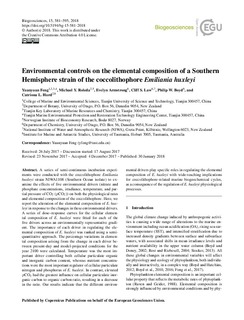| dc.contributor.author | Feng, Yuanyuan | |
| dc.contributor.author | Roleda, Michael | |
| dc.contributor.author | Armstrong, Evelyn | |
| dc.contributor.author | Law, Cliff S. | |
| dc.contributor.author | Boyd, Philip W. | |
| dc.contributor.author | Hurd, Catriona L. | |
| dc.date.accessioned | 2018-09-14T11:08:09Z | |
| dc.date.available | 2018-09-14T11:08:09Z | |
| dc.date.created | 2018-04-20T13:07:52Z | |
| dc.date.issued | 2018-01-30 | |
| dc.identifier.citation | Biogeosciences. 2018, 15 581-595. | nb_NO |
| dc.identifier.issn | 1726-4170 | |
| dc.identifier.uri | http://hdl.handle.net/11250/2562670 | |
| dc.description.abstract | A series of semi-continuous incubation experiments were conducted with the coccolithophore Emiliania huxleyi strain NIWA1108 (Southern Ocean isolate) to examine the effects of five environmental drivers (nitrate and phosphate concentrations, irradiance, temperature, and partial pressure of CO2 (pCO2// on both the physiological rates and elemental composition of the coccolithophore. Here, we report the alteration of the elemental composition of E. huxleyi in response to the changes in these environmental drivers. A series of dose–response curves for the cellular elemental composition of E. huxleyi were fitted for each of the five drivers across an environmentally representative gradient. The importance of each driver in regulating the elemental composition of E. huxleyi was ranked using a semiquantitative approach. The percentage variations in elemental composition arising from the change in each driver between present-day and model-projected conditions for the year 2100 were calculated. Temperature was the most important driver controlling both cellular particulate organic and inorganic carbon content, whereas nutrient concentrations were the most important regulator of cellular particulate nitrogen and phosphorus of E. huxleyi. In contrast, elevated pCO2 had the greatest influence on cellular particulate inorganic carbon to organic carbon ratio, resulting in a decrease in the ratio. Our results indicate that the different environmental drivers play specific roles in regulating the elemental composition of E. huxleyi with wide-reaching implications for coccolithophore-related marine biogeochemical cycles, as a consequence of the regulation of E. huxleyi physiological processes. | nb_NO |
| dc.language.iso | eng | nb_NO |
| dc.rights | Navngivelse 4.0 Internasjonal | * |
| dc.rights.uri | http://creativecommons.org/licenses/by/4.0/deed.no | * |
| dc.subject | Emiliania huxleyi | nb_NO |
| dc.title | Environmental controls on the elemental composition of a Southern Hemisphere strain of the coccolithophore Emiliania huxleyi | nb_NO |
| dc.type | Journal article | nb_NO |
| dc.type | Peer reviewed | nb_NO |
| dc.description.version | publishedVersion | nb_NO |
| dc.rights.holder | © Author(s) 2018 | nb_NO |
| dc.subject.nsi | VDP::Landbruks- og Fiskerifag: 900::Landbruksfag: 910 | nb_NO |
| dc.source.pagenumber | 581-595 | nb_NO |
| dc.source.volume | 15 | nb_NO |
| dc.source.journal | Biogeosciences | nb_NO |
| dc.identifier.doi | 10.5194/bg-15-581-2018 | |
| dc.identifier.cristin | 1580644 | |
| cristin.ispublished | true | |
| cristin.fulltext | original | |
| cristin.qualitycode | 1 | |

